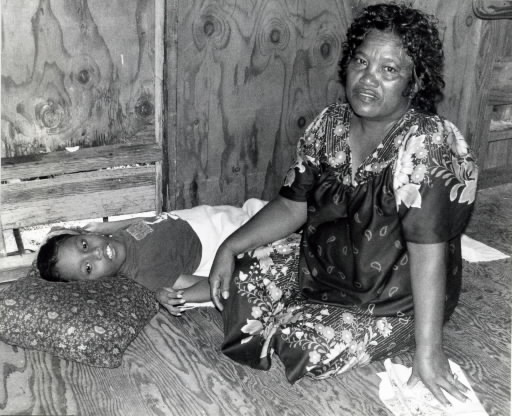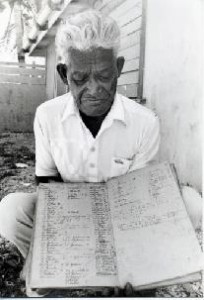2. Children Suffering from Previously Unknown Diseases
Feb. 1, 2013
Chapter 3: The Central, South Pacific and Australia
Part 1: The Nuclear Refugees of the Marshall Islands
Part 1: The Nuclear Refugees of the Marshall Islands
Profoundly disturbing—the photographs we were shown could not be described in any other way. The child in the picture had some features that were recognizable as eyes, nose, and a mouth. But its arms, legs, and torso were completely undeveloped.
Willy Mwekto of the Rongelap Liaison Office in Majuro, the seat of the U.S. government in the Marshall Islands, showed us this photo of a stillborn child when we visited him. It was dated January 9, 1989. The baby's parents, who had been brought up on Rongelap, had fled their home along with the other islanders four years previously.
Mwekto's hand shook with anger as he held up the photo. "Does this look like a human baby to you?" he demanded. "Can you think of anything else that could have done this but radioactive fallout?"
We returned to the Rongelap islanders' new home on the island of Mejatto. There we visited one of the simple tin-roofed huts of the villagers, where eleven-year-old Kimo Jorju lay bedridden in a dimly lit room about five yards square. He was unable to talk or stand. Staring beyond us, he groaned with pain every now and then. Kimo's grandmother, Tanira, was looking after him as his parents had been in hospital in Hawaii for quite some time.
"This poor little boy," she said, "he's been like this since just before his first birthday. The poison got his grandfather as well, you know. That's the only thing it can be—we've never had so many people sick in our family before."
The former Rongelap islanders are given medical examinations twice a year by doctors from the Brookhaven National Laboratory in New York, who are sent out by the Department of Energy. Kimo, who lived on Rongelap until he was seven, is one of those who receives a checkup. Tanira always makes a point of asking the doctors if they think her grandson's illness was caused by the poison, but invariably her questions remain unanswered.
The islanders know two things for certain: ever since radioactive material rained down on them in March 1954, they have fallen victim to a host of previously unknown diseases; and secondly, the majority of casualties have been small children.
The Brookhaven National Laboratory published a report in 1981 which recognized the statistical relationship between the radiation and the incidence of diseases in children. It noted that of the twenty-two islanders who were children under the age often at the time of the Bravo test, seventeen have thyroid conditions.
The radioactive material iodine-131, which was released into the atmosphere at the time of the test and which later fell on the island, was absorbed into the thyroid glands of the children, where it destroyed the ability of that gland to excrete the growth hormone. Not only were children affected, but also 9.1 percent of adults have been found to be suffering from thyroid problems. The relationship between the high incidence of thyroid conditions and exposure to huge doses of radiation cannot be denied.
There is no doctor on Mejatto—just one man with nursing qualifications, the minister, John Pearson. He informed us that miscarriages, stillbirths, and babies born with deformities became common occurrences among the Rongelap islanders after the tests. According to Pearson, fourteen islanders had died since moving to Mejatto four years previously, and of these, seven were children under ten.
"No doubt malnourishment plays a part as well, but the effect of exposure to large doses of radiation cannot be ignored."
The village headman of Rongelap at the time of the 1954 hydrogen bomb test was John Anjain, who is now aged sixty-seven. At present he is living on Ebeye, in the Kwajalein Atoll group. When we visited him at his home there, he showed us an old, tattered notebook.
Anjain began his record, Rongelap Exposed, in 1963, nine years after the test, when thyroid problems first began to appear among the islanders. This is the only such record kept by anyone exposed to the radiation.
The notebook contained a list of eighty-six names: the sixty-three people living on Rongelap, nineteen living on the nearby atoll of Ailinginae at the time of the test, and four babies born after the tests. In the margin were two types of mark: black stars and white stars. The black stars indicated that the person had already died and the white stars that they had had a thyroid operation. Altogether there were twenty-six black stars and thirty-six white stars. Only twenty-four of the eighty-six had no mark by their names. In other words, sixty-two of the islanders had died or had suffered lasting effects from exposure to radiation.
Among the names with a black star was Lekoj Anjain, the headman's son who died in 1972 of leukemia at the age of nineteen. In a broken voice Anjain recalled his son toddling around as a little boy, chuckling gleefully while the ashes fell.
Anjain told us of the tragic case of one woman for whom an operation had come too late. Her swollen throat burst and she vomited blood and a bluish substance before dying in great pain.
Year after year, he has kept this heartbreaking record of the deaths of his people. Of the thirty-six who have had operations on their thyroid glands, at least five were found to have cancer. Operations alone, however, cannot save the people from the legacy of radioactive fallout.
Believing the assurances of the U.S. government, the islanders returned home three years after the testing. When Anjain began to keep his record in 1963, American medical teams still insisted that there was nothing to worry about, despite the appearance of previously unknown diseases among the islanders.
"The Americans knew exactly what was going on. We were the ones who didn't realize that we were being used as part of a human experiment—we were nothing but guinea pigs," said Anjain. Ebeye, where he lives, is a small island one mile long and a little over two hundred yards wide. Nine thousand people are crammed onto this tiny area of land. From Ebeye can be seen the main island of Kwajalein, which, with its radar dishes and antennae, is an important site of U.S. nuclear warfare operations. It is used as a landing site for missiles fired from the mainland United States and is an integral part of the SDI (Strategic Defense Initiative) program. The basis of Ebeye's economy has become the $9 million rent paid each year by the American government, and the employment provided by the base. Even if the residents do not like the idea of having missiles exploding on their doorstep, their fortunes are too tied to those of the base to complain about it.
When we visited Anjain, he and a number of other islanders were preparing to go to the United States to plead for food supplies to be sent to the Rongelap islanders now living on Mejatto. They planned to hold talks at the United Nations in New York as well as in Congress. It would be their seventeenth journey to the country whose policies had caused them so much pain.
However, not one word of anger, resentment, or frustration was included in the draft of their request for aid.
"We can only do the same as we always have," said Anjain, holding the yellowing notebook in his hand. "Just try as hard as we can, and pray for the best."









